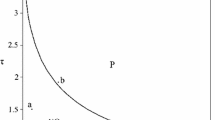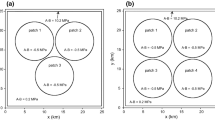Abstract
Can a simple multi-block-spring model with total symmetry make interesting predictions for fault behaviour? Our model consists of a symmetric, slowly driven, two degree-of-freedom block-spring system with static/dynamic friction. The simple friction law and slow driving rate allow the state of this fourth order system to be described between slip events by a single variable, the difference in the stretch of the driving springs. This stretch difference measures the locked-in stress and is closely related to fault stress inhomogeneity.
In general,smoothing is not observed. A spatially homogeneous stress state is found to almost always be unstable, in that the system tends toward an inhomogeneous state after many slip events. The system evolves either to a cycle that alternates between two types of earthquakes, or to a cycle with repeating but identical asymmetric earthquakes. One type of alternating earthquake solution is structurally unstable, which implies a great sensitivity to model perturbations.
For this simple model, spatial asymmetry necessarily occurs, despite the symmetry in the model, thus suggesting that spatial structure in seismicity patterns may be a consequence of earthquake dynamics, not just fault heterogeneity.
Similar content being viewed by others
References
Andrews, D. (1975),From antimoment to moment: Plane-strain models of earthquakes that stop. Bull. Seis. Soc. Am.65, 163–182.
Andrews, D. (1978),Coupling of energy between tectonic processes and earthquakes. J. Geophys. Res.83, 2259–2264.
Blanpied, M. andTullis, T. (1986),The Stability and Behavior of a frictional system with a two state variable constitutive law. PAGEOPH124, 415–444.
Burridge, R. andKnopoff, L. (1967),Model and theoretical seismicity. Bull. Seis. Soc. Am.57, 341–371.
Byerlee, J. (1970),The Mechanics of Stick-slip. Tectonophysics9, 475–486.
Byerlee, J. (1978),Friction of rocks. PAGEOPH116, 616–626.
Cao, T., andAki, K. (1984),Seismicity simulation with a mass-spring model and a displacement hardening-softening friction law. PAGEOPH122 10–23.
Cao, T. andAki, K. (1986),Seismicity simulation with a rate and state dependment friction law. PAGEOPH124, 487–513.
Cohen, S. (1977),Computer simulation of earthquakes. J. Geophys.Res.82, 3781–3796.
Devaney, R. An Introduction to Chaotic Dynamical Systems (Benjamin/Cummings Publishing Company, Menlo Park, 1986).
Dieterich, J. (1972),Time-dependent friction as a possible mechanism for aftershocks. J. Geophys. Res.77, 3771–3781.
Dieterich, J.,Experimental and model study of fault constitutive properties. InSolid Earth Geophysics and Geotechnology (ed. Nemet-Nasser) (ASME, NY. 1980) pp. 21–30.
Dieterich, J.,Constitutive properties of faults with simulated gouge. InMechanical Behavior of Crystal Rocks (ed. Carter, N. et al.) (Geophys. Monogr.24, AGU, Washington, D.C. 1981) pp. 103–120.
Gu, J., Rice, J., Ruina, A. andTse, S. (1984),Slip motion and stability of a single degree of freedom elastic system with rate and state dependent friction. J. Mech. Phys. Solids32, 167–196.
Guckenheimer, J. andHolmes, P. Nonlinear Oscillations, Dynamical Systems, and Bifurcations of Vector Fields (Springer-Verlag, New York, 1983).
Horowitz, F. andRuina, A. (1987),Frictional slip patterns in a spatially homogeneous elastic fault model, in revision for J. Geophys. Res.
Israel, M., andNur, A. (1979),A Complete solution of a one-dimensional propagating fault with nonuniform stress and strength. J. Geophys. Res.85, 2223–2233.
Nur, A. (1978),Nonuniform friction as a physical basis for earthquake mechanics. PAGEOPH116, 964–991.
Rice, J. andTse, S. (1986),Dynamic motion of a single degree of freedom system following a rate and state dependent friction law. J. Geophys. Res.91, 521–530.
Ruina, A. (1983),Slip instability and state variable friction laws. J. Geophys. Res.88, 10359–10370.
Weeks, J. andTullis, T. (1985),Frictional sliding of dolomite: A variation in constitutive behavior. J. Geophys. Res.90, 7821–7826.
Author information
Authors and Affiliations
Rights and permissions
About this article
Cite this article
Nussbaum, J., Ruina, A. A two degree-of-freedom earthquake model with static/dynamic friction. PAGEOPH 125, 629–656 (1987). https://doi.org/10.1007/BF00879576
Received:
Revised:
Accepted:
Issue Date:
DOI: https://doi.org/10.1007/BF00879576




